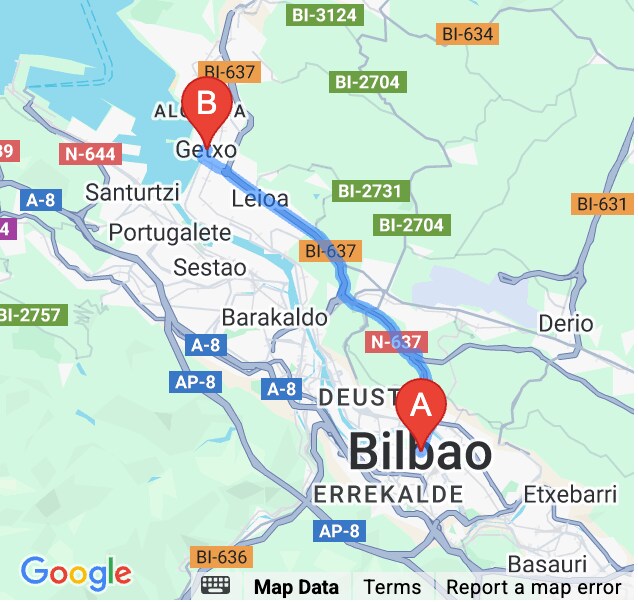Beyond Bilbao

GETXO

Everyone loves to be beside the seaside, and the coastal delights of nearby Getxo are likely to put a salty smile on everyone’s face. The untamed exquisiteness of the region can be seen from the clifftops at La Salvaje (literally, The Wild) beach, where surfers expertly ride on the whipped up waves rolling in from the Bay of Biscay. If the mood takes you, locally operated schools will give you a taste of the ocean up close through one of many watery experiences; scuba diving, canoeing, surfing and boat trips are readily available.
If you’re doing a loop back to Bilbao from here, be sure to take the slightly longer route via the Vizcaya Bridge — a remarkable 120-year-old iron structure designed by the same man who dreamt up the Eiffel Tower. It’s the only functioning example of its kind in the world.
SAN JUAN DE GAZTELUGATXE

In the Basque dialect, "gaztelugatxe" means “crag of the castle,” a description that, while accurate, doesn’t quite do justice to this seriously cool retreat on a rock. This minuscule island houses just one building — an ancient hermitage devoted to John the Baptist that has been set on fire, sacked by Francis Drake, served as a medieval burial ground, attacked by the English and been consistently pummelled by rough seas and high winds. It really is no wonder that there’s a legend stating that anyone who can make it up the 230 steps and ring the bell thrice gets a wish granted.
The 10th-century sanctuary is near the traditional fishing town of Bermeo, a place inundated with the kind of delightful idiosyncrasies you can only find in communities outside the city, and Bakio, with distinct cubic buildings and madcap cultural events. It’s worth a hike even if the weather takes a turn for the worse. Be safe in the knowledge there’ll be a delicious supper of fresh fish waiting for you when you return.
GUERNICA

Known largely due to its depiction by an artistic chap named Picasso, this village to the east is one with a heart-breaking past, suffering in the spate of bombings conducted by the German Luftwaffe in 1937. Two great symbols of survival remained after the terrible event — the Biscayan Assembly and Gernikako Arbola (an ancient oak used as a meeting place and ceremonial location). Since then, a beautifully resolute Basque town with plenty to be proud of has risen from the ashes.
There are plenty of churches, museums, sculptures and sporting venues to visit, this being an area where the thrilling game of Jai Alai is held in the highest regard. Heed the local saying, “Lunes gerniqués, golperik ez” (Not a stroke of work gets done on Mondays) and be prepared to be swept up in crowds if you visit on this customary market day.
URDAIBAI

Two exceptional attractions are in this outstanding UNESCO Biosphere Reserve. Cueva de Santimamiñe is an ancient cavern that transports you back 12,000 years. Paintings created during the Palaeolithic era can be seen on the walls. It’s a rare chance to come face to face with our ancestors, made better by the addition of a 21st-century virtual tour in the nearby San Mames interactive centre.
Second is the enthralling Bosque de Oma — an “enchanted” forest filled to the brim with art. Dreamt up by Agustín Ibarrola in the 1980s, this is a woodland walk like no other, where the patterns and figures painted on the towering pine trees change depending on your personal perspective. A living, breathing Rorschach test for the mind, body and soul, it’s a safe bet that none of your neighbours will have experienced anything quite like it.
LOGROÑO

A traveller-centric alternative to the hip streets of San Sebastian, this far less famous inland city is just as much of a food lover’s haven as its coastal counterpart. Head to Calle Laurel for the best of the lively local bars that peddle delicious bite-sized pintxos (a gourmand’s take on tapas) and outstanding wine flowing in from the La Rioja region’s abundant vineyards.
Once you’ve had your fill, the streets of the former Roman settlement are themselves something to savour, and you’re highly likely to happen across more than one fascinating historical feature as you explore. The museum, located in the 18th-century Espartero Palace, offers insight into the area’s deepest roots — including its dark side during the Basque Country witch trials. The Knight’s Templar’s mysterious “Jego de la Orca” (Game of the Goose) will pique everyone’s curiosity. Those seeking something a bit more spiritual may wish to take a trek along the Camino de Santiago, a well-worn pilgrim’s route that people have been tramping since medieval times. Religious or not, you’ll find the panoramic views very enlightening.





